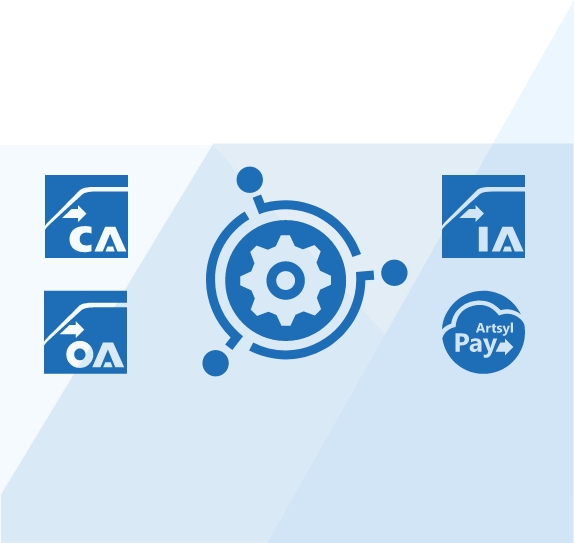Managing a small business is inherently stressful. You have to keep track of every aspect of the business and make sure everything runs smoothly. An essential part of running a successful business is invoicing. If you’re managing a small business, you know how difficult it can be to keep track of all your invoices.
Fortunately, technology offers a solution to this problem- recurring invoicing. In this blog post, we’ll explain why recurring invoicing is so beneficial for small business owners.
Still spending countless hours on manual invoicing? Switch to Artsyl InvoiceAction today and transform your billing process into a fully automated, error-free operation. Take control of your revenue streams and never miss an invoice again.
Experience the future of invoicing!
Book a demo now
What is Recurring Invoice?
A recurring invoice is a type of invoice that is scheduled to be sent automatically at regular intervals over a specified period. These intervals could be weekly, monthly, quarterly, or any other time frame that is agreed upon between the vendor and the customer.
Recurring invoices are common in long-term contractual relationships where the goods or services being provided—and their costs—remain consistent over time.
Recurring invoices are particularly useful in scenarios such as:
- Subscription-based services (e.g., software, magazines)
- Lease or rental agreements
- Ongoing consultancy services
- Maintenance or retainer contracts
- Utility payments for long-term contracts
As a business owner, you know that time is money and any process that can be streamlined, is one that is worth automating. Invoicing can be one of the most tedious tasks you encounter on a routine basis.
Whether you are sending out invoices for products sold or services rendered, the time it takes to create, send, and track these invoices can add up quickly. This is where recurring invoices come in, offering a wealth of benefits beyond just saving time.
Are you striving for operational efficiency? Artsyl OrderAction enables you to manage your sales orders effortlessly, freeing up valuable time for you to focus on what really matters—growing your business. Don’t let manual order processing hold you back!
Book a demo now
Key Benefits of Recurring Invoices
Recurring invoices offer several benefits beyond just saving time. They help to stabilize your cash flow so you know what to expect in terms of income. This also makes it easier to budget and plan expenses effectively. It also minimizes errors and disputes, as invoices are created with the same information each time, reducing discrepancies.
- Automated Billing: One of the main benefits is automation. Once set up, the invoice is automatically generated and sent to the customer without manual intervention, saving time and administrative effort.
- Consistency: Recurring invoices help maintain consistency in billing cycles, which is beneficial for both the supplier and the customer. It helps in budgeting and financial planning.
- Fixed Details: Most of the invoice details such as customer information, payment terms, and often even the items being billed, remain the same across different billing cycles.
- Variable Components: While many elements are fixed, recurring invoices can sometimes accommodate variable components like usage-based charges, which can change from one billing period to another.
- Duration: Recurring invoices are usually associated with an agreed-upon duration, which could be until the end of a contract, a particular project, or any other milestone.
Billing errors can cost you not just money, but also your reputation. With Artsyl docAlpha intelligent financial process automation, you ensure that every bill sent out is accurate, timely, and compliant with industry regulations. Maintain your business integrity and keep
your customers happy.
Book a demo now
5 Reasons to Adopt Recurring Invoicing
The most significant benefit of recurring invoicing is it saves a lot of time that business owners can use for more crucial tasks. By automating the invoicing process using specialized tools, you won’t have to spend hours every month creating invoices.
Once you create a recurring invoice profile, the software automatically generates invoices and sends them to your customers on the scheduled date.
Recurring Invoice Improves Cash Flow
Cash flow is everything in small businesses, and it’s important to keep it consistent by getting paid on time. Recurring invoicing is a reliable way to ensure that your customers’ payments remain on track. Invoicing software sends invoices to customers automatically, which means there are fewer chances that they’ll miss their payments. This, in turn, ensures that your business has enough money to continue to operate.
Invoice Automation Software
Related Videos
Recurring Invoice Enhances Customer Relationships
Customers are the lifeblood of any business. It is essential to have a good relationship with them and ensure they’re happy with your products and services. One way to achieve this is by using recurring invoicing. When invoices are sent on time automatically, you show your customers that you’re organized and efficient, increasing their confidence in your business.
Recurring Invoice Improves Accuracy and Reduces Errors
Manual invoicing is more prone to errors than automated ones. Recurring invoicing eliminates the likelihood of human error by providing a more streamlined and accurate invoicing process. By automating the invoicing process using software, invoicing becomes an efficient and more reliable part of your business process.
Recurring Invoice Allows Better Forecasting
Recurring invoicing helps you manage your accounts receivable accurately. You can forecast how much money will be coming in monthly or annually, making it easier to budget your expenses. This level of predictability is often critical for small businesses, particularly those that work on tight margins.
Ready to optimize your invoicing and witness a tangible impact on your cash flow? Artsyl InvoiceAction is your solution for managing recurring invoices seamlessly. Automated, consistent, and secure—Just how modern invoicing should be. Take the first step towards smarter finance!
Book a demo now
Recurring Invoices in Real Life Business Situations
In real-life business scenarios, recurring invoices are used across various industries to streamline billing processes, reduce administrative workload, and ensure consistent revenue streams. Below are some examples illustrating how recurring invoices are utilized in different sectors:
Subscription Services
Software-as-a-Service (SaaS) companies often rely on recurring invoices to bill their clients for monthly or yearly subscription fees. Automation makes it easy for both parties, ensuring continuous access to the software while maintaining a predictable revenue flow for the provider.
Property Leasing
Commercial and residential property owners typically send out recurring invoices for rent. Both landlords and tenants benefit from the consistency; tenants can budget for their expenses, and landlords have a reliable income stream.
Consultancy Services
Management consultants providing long-term advisory services might opt for recurring invoices to bill retainer fees. Recurring invoice simplifies the billing process and ensures consistent revenue, allowing consultants to focus more on delivering quality service.
Utility Companies
Utilities like electricity, water, or internet services commonly use recurring invoicing. Invoice automation helps in scaling operations and reduces the scope for billing errors.
Gym Memberships
Gyms and fitness centers usually bill members on a recurring basis for membership fees. Recurring invoices ensure a steady cash flow and minimize the administrative burden of manual billing.
Legal Services
Law firms offering long-term legal counsel to corporate clients may employ recurring invoices for their retainer agreements. Consistent invoicing helps with financial planning for both the law firm and the client.
Maintenance Contracts
Companies offering maintenance services, like HVAC maintenance or IT support, often set up recurring invoices for their long-term contracts. The predictability makes it easier for clients to budget for maintenance costs while guaranteeing the service provider a regular income.
Recurring invoices offer numerous advantages for sustaining long-term business relationships, but they also require prudent management. Implementing them effectively necessitates a nuanced understanding of both the technological aspects and the customer relations component of the billing process.
Looking for a solution that offers more than just invoicing? Artsyl OrderAction doesn’t just automate your sales orders; it also provides real-time alerts and analytics, helping you make data-driven decisions for your business.
Make the smart choice for your
order management process.
Book a demo now
Best Practices of Recurring Invoices
- Clear Agreement: Both parties should agree on the use of recurring invoices, the billing cycle, and what charges are included.
- Transparency: Keep the client informed about the recurring invoice schedule and any additional charges that might be applied. Notify the customer in advance about upcoming invoice generation and any potential changes in rates or terms.
- Review and Update: Periodically review recurring invoices to update any changes in rates, terms, or other billing components.
- Flexibility: Allow easy modification or cancellation of the recurring invoice setup to accommodate changing client needs.
- Compliance: Ensure that your invoicing practices comply with local, state, and federal regulations to avoid legal issues.
- Prompt Notifications: Automatically notify clients a few days before the invoice is due and again when the payment is processed.
- Payment Follow-up: Even though invoicing is automated, monitoring payments to ensure they are made according to agreed-upon terms remains crucial.
- Regular Review: Periodically review your recurring invoice settings to ensure they align with current service terms and legal requirements.
Recurring invoices offer a convenient, efficient method of billing for ongoing transactions, but they also require careful management to ensure they meet the needs of both the vendor and the customer. They should be part of a broader financial management strategy that includes regular review and updates.
Recurring Invoice Automation with InvoiceAction
Automating recurring invoices with a specialized solution like Artsyl InvoiceAction offers a myriad of benefits that can significantly impact operational efficiency, cash flow management, and customer satisfaction. InvoiceAction is designed to streamline the process of invoice generation, management, and automation. Here’s how it can specifically assist with recurring invoices in various business contexts:
One of the primary benefits of automating invoicing with InvoiceAction is the considerable time saved that would otherwise be spent on manual data entry and invoice generation. Automation allows you to allocate resources to more strategic tasks.
In addition, automated systems minimize the risk of errors associated with manual invoicing, such as incorrect amounts, wrong customer details, or omitted line items.
To aid predictability of revenue streams and financial planning, recurring invoices ensure that billing occurs at regular intervals. InvoiceAction allows for a high degree of customization, enabling you to set different billing cycles, payment terms, and variable components tailored to each customer’s needs.
And with built-in features for tax calculations, currency conversion, and compliance checks, the software ensures that your invoices meet legal and industry standards.
InvoiceAction Implementation Steps
- Define the parameters for your recurring invoices, such as billing frequency, payment terms, and line items.
- Ensure that Artsyl InvoiceAction is integrated with your existing CRM, ERP, or accounting software for seamless data transfer.
- Run a test phase to check for any glitches or issues that need to be addressed before full-scale implementation.
- Once testing is successful, roll out the recurring invoice automation to your entire customer base.
- Regularly update and review the system to keep up with changes in pricing, taxation, and compliance requirements.
Automating recurring invoices with Artsyl InvoiceAction can transform your invoicing processes, making them more efficient, error-free, and compliant. It provides a scalable solution that grows with your business, thus future-proofing your billing operations.

Expanding your business?
Scaling is a breeze with Artsyl docAlpha. Our flexible intelligent process automation platform adapts to your growing customer base and varying billing requirements, making the transition smooth and hassle-free. Prepare your business for growth—Click here to explore how docAlpha can make it happen!
How does automation help with recurring invoices?
Automation plays a pivotal role in the realm of recurring invoices, transforming the way businesses manage their billing processes. By leveraging automation, organizations can streamline and expedite the creation and delivery of recurring invoices. This means invoices are consistently generated at specified intervals, eliminating the potential for human error and ensuring that billing cycles are never missed. This not only enhances operational efficiency but also allows employees to shift their focus from mundane, time-consuming tasks to more strategic and value-added activities, ultimately driving business productivity.
Moreover, automation provides an invaluable aid in the area of compliance and reporting. Automated systems are capable of ensuring that tax rates are correctly applied and regulatory requirements are met, reducing the risk of compliance-related errors. Additionally, they offer the ability to generate comprehensive reports, shedding light on invoice status, payment history, and financial performance. With these insights at their disposal, businesses can make more informed decisions, optimize their financial processes, and maintain a tighter grip on their overall financial health. In essence, automation empowers businesses to elevate their financial management to a new level of accuracy, efficiency, and control.
What are the potential benefits of using recurring invoices for cash flow management?
Recurring invoices are a valuable tool for maintaining healthy cash flow within a business. Their primary benefit lies in their predictability. By automating the invoicing process for recurring services or subscriptions, companies can anticipate and rely on a consistent inflow of revenue. This predictability, in turn, allows for better financial planning and budgeting, helping businesses avoid cash flow crises and unexpected shortfalls. Additionally, recurring invoices minimize the administrative burden, as they require less time and effort to generate and send compared to one-time invoices. This operational efficiency ensures that the focus remains on core business activities rather than manual invoicing tasks, ultimately contributing to better cash flow management.
Furthermore, recurring invoices enhance customer relationships. They provide transparency, as customers know when to expect invoices, making it easier for them to plan and budget for payments. This predictability and convenience can lead to improved customer satisfaction and loyalty. In sum, recurring invoices promote financial stability, operational efficiency, and positive customer relationships – all of which contribute to effective cash flow management.
Can I customize the content and format of recurring invoices?
The ability to customize the content and format of recurring invoices is a standard feature offered by most invoicing and accounting software. This customization allows you to tailor your invoices to your specific business needs and branding. You can typically adjust the following aspects:
- Invoice Information: Customize the header with your company logo, name, and contact information.
- Recipient Details: Include your customer’s name, address, and contact details.
- Invoice Line Items: Add, edit, or remove line items to reflect the products or services provided.
- Pricing: Set your own pricing, tax rates, and discounts.
- Payment Terms: Specify the due date and payment methods.
- Terms and Conditions: Include any specific terms, notes, or special instructions.
- Design and Layout: Choose a layout and style that matches your brand’s aesthetics.
Customizing recurring invoices ensures that they align with your brand identity, maintain a professional appearance, and provide all the necessary information for clear communication with your customers. This flexibility is a valuable feature for businesses of all sizes.
How do I set up and manage recurring invoices in accounting software?
Setting up and managing recurring invoices in accounting software typically involves the following steps:
- Select the Right Software: Ensure your accounting software supports recurring invoices. Most reputable accounting software options offer this feature.
- Create a Recurring Invoice Template:
- Access the recurring invoice feature in your accounting software.
- Set up a new recurring invoice template.
- Define the invoice’s basic details, such as the customer, invoice number, and description.
- Choose the Billing Schedule:
- Specify the frequency (e.g., monthly, quarterly) and the start date for invoice generation.
- Select the duration or end date for recurring invoices (if applicable).
- Customize Invoice Details:
- Add line items for the products or services you provide.
- Set the pricing, taxes, and discounts as needed.
- Include any specific terms, notes, or payment instructions.
- Review and Save:
- Double-check all the details to ensure accuracy.
- Save the recurring invoice template.
- Automate Generation and Sending:
- Configure the software to automatically generate and send the recurring invoices on the specified dates.
- Set up email notifications to alert you and your customers when invoices are sent.
- Monitor and Manage:
- Regularly review the generated invoices to confirm accuracy.
- Address any changes or updates as needed, such as modifications to pricing or services.
- Track payments and manage outstanding invoices.
- Generate Reports:
- Accounting software often provides reporting tools to track recurring invoice performance and revenue.
By following these steps, you can effectively set up and manage recurring invoices within your accounting software, which helps streamline the billing process and ensures regular, on-time invoicing for your customers.
What happens if there are changes to the recurring invoice details?
When changes are required for recurring invoice details, such as adjustments to pricing, services, or terms, you should follow these steps to ensure accurate billing and maintain good customer relations:
- Access the Recurring Invoice Template: Go into your accounting software and access the recurring invoice template that needs modification.
- Edit the Template: Make the necessary changes to the template. Update the pricing, add or remove line items, adjust tax rates, or revise terms and conditions as needed to reflect the new details accurately.
- Review and Verify: Double-check all changes to ensure they are correct and align with the updated agreement or contract with the customer.
- Save the Updated Template: Save the changes to the recurring invoice template. The software should prompt you to apply the changes to future recurring invoices.
- Notify the Customer: If the changes impact the customer’s billing or terms, it’s important to communicate these modifications. Send them a notification or updated invoice if required, ensuring transparency and preventing any confusion.
- Monitor the Next Invoice: Keep an eye on the next generated invoice to confirm that the adjustments have been properly applied.
By following these steps, you can effectively handle changes to recurring invoice details, maintaining accuracy, transparency, and customer satisfaction throughout the process.
Are there any best practices for managing and tracking recurring invoices?
There are several best practices for managing and tracking recurring invoices efficiently:
- Standardize Invoice Templates: Create standardized invoice templates for recurring services to ensure consistency and reduce the risk of errors.
- Set Up Automation: Utilize accounting software to automate the generation and delivery of recurring invoices on specified dates, reducing manual effort and minimizing the risk of missed billing cycles.
- Document Agreements: Maintain detailed records of customer agreements and contract terms, including pricing, billing frequency, and payment methods, to ensure accurate invoicing.
- Use Invoice Numbers: Assign unique invoice numbers to each recurring invoice for easy tracking and reference.
- Monitor Payment Status: Regularly check the payment status of recurring invoices to identify overdue payments and follow up with customers promptly.
- Implement Payment Reminders: Configure your software to send automated payment reminders to customers before or on the due date to reduce late payments.
- Keep a Clear Audit Trail: Maintain a clear audit trail of all invoices and related communications to resolve disputes or discrepancies.
- Regularly Review Invoices: Periodically review invoices to ensure accuracy and that they align with updated agreements or changes in services.
- Generate Reports: Leverage the reporting capabilities of your accounting software to track recurring invoice performance, revenue, and payment trends.
- Customer Communication: Maintain open and clear communication with customers, promptly addressing any questions, concerns, or issues related to recurring invoices.
- Data Security: Ensure the security of financial data related to recurring invoices by using secure, encrypted software and practices.
- Customer Feedback: Collect feedback from customers about their invoicing experience and use this input to improve your invoicing process.
By implementing these best practices, you can enhance the management and tracking of recurring invoices, improve cash flow, and maintain strong customer relationships.
Final Thoughts: Recurring Invoice Is a Business Timesaver
Business owners face many challenges, and one of the most significant is keeping their finances in check. Invoicing is a crucial aspect of managing a business, and recurring invoicing can make it easier and more efficient.
By automating the recurring invoicing process, small businesses can save time, reduce errors, improve cash flow, enhance customer relationships, and forecast their finances better. It’s time to embrace technology and start using recurring invoicing to help take your small business to the next level.



 Credit Invoice or Credit Note? Find Out The Difference
Credit Invoice or Credit Note? Find Out The Difference Interim Invoice: What Is It?
Interim Invoice: What Is It? Your Guide to Commercial Invoices
Your Guide to Commercial Invoices The Basics of an Invoice: The Standard Invoice
The Basics of an Invoice: The Standard Invoice The Ultimate Guide to Final Invoices
The Ultimate Guide to Final Invoices Self-Billing Invoice: What Is It?
Self-Billing Invoice: What Is It?



